In Saxony, culture goes hand-in-hand with nature, and one of the many pleasures awaiting the visitor is driving or cycling on roads almost free of traffic. We drove from Leipzig through Dresden and on towards the medieval towns of Görlitz and Bautzen on near empty roads, bordered by massive tracts of yellow rape (the size of the fields a relic of communist collectivisation), the wind turbines on the horizon for all the world like giants with flailing arms striding across the hills.

Architectural Gems of Saxony - Gorlitz and Bautzen
by Maritravel
For many years the delights of German Saxon towns remained hidden due to its location in the former East Germany. Now, these medieval towns are once more in the limelight
Gőrlitz, Architecture Untouched Despite Wars
The 930 year old town of Gőrlitz shares a border with Poland and Czechoslovakia (Prague in a mere 160 Kl. away), its glorious architecture virtually untouched despite the wars that raged across the land. To stand on the German side of the Peace Bridge and look at the blue, yellow and pink facades of the houses across the river on the Polish side, is to feel the full weight of recent history.
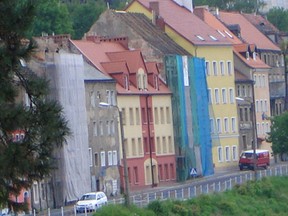
Prior to World War II, Gőrlitz straddled both banks of the River Neisse but when the Allies redrew the boundaries after the war and divided Germany between the western powers and the Soviet Union, it lost its eastern suburbs. Fortunately for posterity, lack of money prevented the Soviets from knocking down and rebuilding the heart of the town in utilitarian style as they did in Dresden and Leipzig. 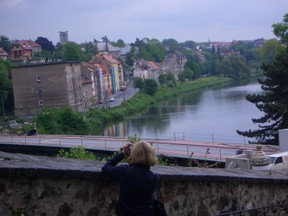
A walk through the crooked, narrow streets on the 15th century basalt cobblestones, forged from the mountain just outside the town, takes you on a fascinating journey through the past. Throughout its dynamic history, this former textile trading town has exercised special political importance, initially by its position and importance as a medieval trading post and then by its transformation into a residence for the bourgeoisie in the 19th and 20th centuries. 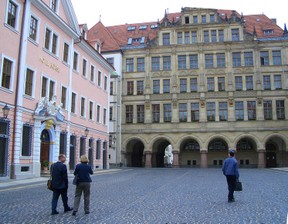
Architecture of Gorlitz
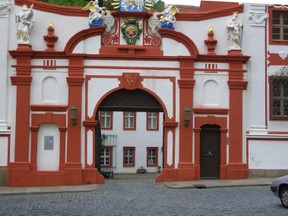 Due to its position on the trade route to important places like Frankfurt, Leipzig, and Krakow, and to a special privilege granted to the town, all merchants passing through were obliged to offer their wares in Gőrlitz, giving rise to houses with impressive inner yards where the textiles could be displayed.
Due to its position on the trade route to important places like Frankfurt, Leipzig, and Krakow, and to a special privilege granted to the town, all merchants passing through were obliged to offer their wares in Gőrlitz, giving rise to houses with impressive inner yards where the textiles could be displayed. 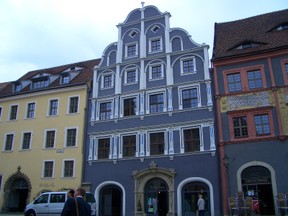 Enormous squares, the sides lined by the houses of the rich merchants who dealt in wool and furs in the days when Gőrlitz dominated the trade, richly decorated house fronts, fortifications and fortified towers, sacred buildings from the Gothic, Renaissance, Baroque, Art Nouveau and Bauhaus eras have the effect of turning the town into a 3-dimensional reference book of the history of architecture.
Enormous squares, the sides lined by the houses of the rich merchants who dealt in wool and furs in the days when Gőrlitz dominated the trade, richly decorated house fronts, fortifications and fortified towers, sacred buildings from the Gothic, Renaissance, Baroque, Art Nouveau and Bauhaus eras have the effect of turning the town into a 3-dimensional reference book of the history of architecture. 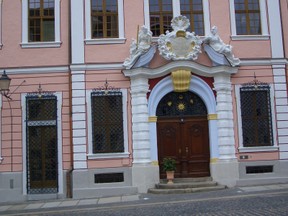
Renaissance, Baroque and Art Nouveau
In the part arcaded Untermarkt (Lower Market Place) is grouped one of the finest collection of Renaissance and Baroque town houses to be seen in Europe, a place of pilgrimage for architects the world over. Indeed, 4,000 of Gőrlitz’s late Gothic, Renaissance, Baroque, Gründerzeit (German Industrial Revolution) and Art Nouveau buildings, are protected as National Monuments.
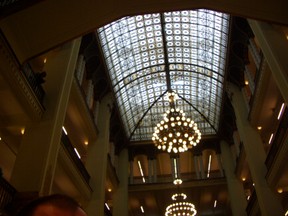 Blending harmoniously with the older buildings are the Gründerzeit and Art Nouveau quarters. The Strassbourg Arcade Department Store with its stunningly beautiful chandeliers and magnificent staircase and the Art Noveau Karstadt Department Store date from the period of urban expansion which started in the 19th century when immigrants from Silesia flocked to the town.
Blending harmoniously with the older buildings are the Gründerzeit and Art Nouveau quarters. The Strassbourg Arcade Department Store with its stunningly beautiful chandeliers and magnificent staircase and the Art Noveau Karstadt Department Store date from the period of urban expansion which started in the 19th century when immigrants from Silesia flocked to the town. 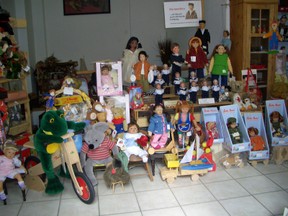
This is a good place to enjoy shopping and to see traditional crafts like jewellry making, porcelain painting and toy-making being carried on by craftsmen. It is also an ideal place to sample the local specialities – a fruit schnapps called Görlitzer Geister and a beer called Landskron.
Tour the town with the Night Watchman
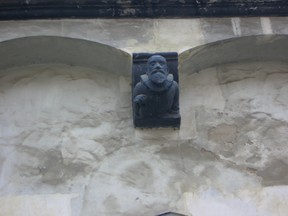 And after you’ve visited the museums, the churches, and the Town Hall, and heard the famous Sun Organ played in the beautifully restored church of St. Peter, a romantic tour of the old town with the Night Watchman will add another, different, dimension to your understanding of Gőrlitz.
And after you’ve visited the museums, the churches, and the Town Hall, and heard the famous Sun Organ played in the beautifully restored church of St. Peter, a romantic tour of the old town with the Night Watchman will add another, different, dimension to your understanding of Gőrlitz. 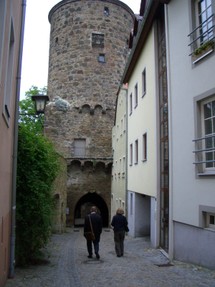 After listening to his grisly stories and sagas you will appreciate the visit to one of the town’s old hostelries for a welcome drink!
After listening to his grisly stories and sagas you will appreciate the visit to one of the town’s old hostelries for a welcome drink!
Beyond Görlitz
Once you have revelled in the small town charm and admired the centuries of architecture in Görlitz, you may want to check out the historic narrow-gauge track in the Zittau mountains 40 Kl. away, or journey to the Czech Republic and spend a day in Prague. There are many kilometres of cycle and hiking tracks along the Oder-Neisse to explore and guided tours by bicycle through the cultural regions of Upper Lusatia, Lower Silesia and Bohemia are easy to arrange. 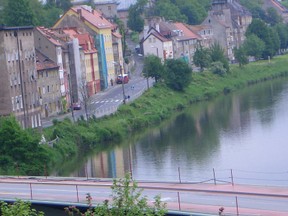 The enthusiasm of the local guides for the area’s art and heritage means that culture plays a large part in the tours, but sampling the local food is not forgotten. Frequent stops are made in beer-gardens along the river for local delicacies washed down with the very special local beer or the equally delicious white wine of the region.
The enthusiasm of the local guides for the area’s art and heritage means that culture plays a large part in the tours, but sampling the local food is not forgotten. Frequent stops are made in beer-gardens along the river for local delicacies washed down with the very special local beer or the equally delicious white wine of the region.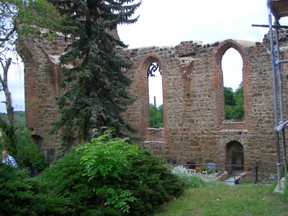
Bautzen, the Centre of Sorbian Culture
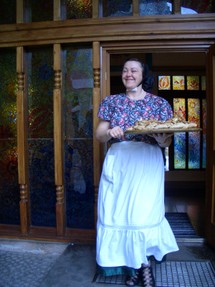 There’s still Bautzen, the town famous for the fact that all political prisoners were sent here at one time, and which celebrated its 1000-year-old existence a few years ago. Although heavily damaged during World War II the town has been restored to something of its former glory.
There’s still Bautzen, the town famous for the fact that all political prisoners were sent here at one time, and which celebrated its 1000-year-old existence a few years ago. Although heavily damaged during World War II the town has been restored to something of its former glory.
It is a mere 40 kl. from Görlitz but a world apart by virtue of the fact that it is the centre of Sorbian culture and the seat of the Sorbian nation, founded by Moravians and Bohemians who had separated from the Catholic Church long before Luther made his break from Rome. 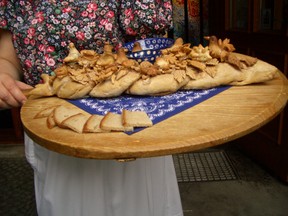
The Sorb culture was supressed by the Nazis during World War II but this was a factor which helped them re-establish it under the new regime in 1945. As the communists had to prove they were better rulers than the Nazis, they made special efforts to re-instate the traditions and language of this Slavic minority, and today, the Sorbians publish their own newspapers, perform in and support Germany’s only bi-lingual folk-theatre, educate their children in Sorbian traditions, speak their own language, and have been effective in ensuring that road signs and official notices in the area are in both German and Sorbian. The cultural museum in Ortenburg Castle tells the story of this Slavic people whose language closely resembles that of Czechoslovakia.
What to do in Bautzen
Bautzen is unique in other ways too, being positioned on a granite plateau above the Spree river and from the Friedensbrücke Bridge there is an awe-inspiring panorama of the 23 medieval towers that dominate what remains of the town wall. In the town centre stands, or leans, another tower, the 1000 year old Reichen Tower, which is1.44 metres off the perpendicular. Visitors should climb to the top for a view of the town centre, rebuilt in Baroque style after the 30-years war in the 17th century.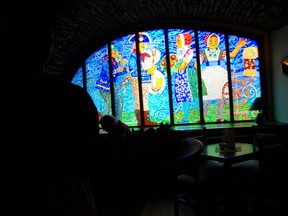
All that sightseeing offers a good excuse – if excuse be needed – to visit the famous Wjelbik restaurant with its splendid stained-glass windows for a typical Sorb meal, served by the owner dressed in her 102 year old traditional Sorb costume who will take great delight in explaining every dish to you, from the dumplings in horseradish sauce to the home-made cinnamon ice-cream.
Bautzen & Görlitz - Part of 6-city alliance
Bautzen and Görlitz once formed part of a six-city alliance which wielded power over the whole of Upper Lusatia. That power has waned, but composers, castles, architecture and arts, are once more energising the life of this beautiful province and their power to charm the visitor is once again their greatest attraction.
Tourist information for Görlitz : Görlitzinformation, Brüderstrasse 1, 02828 Görlitz, Email: [email protected]
Tourist information for Bautzen: Touristinfo Bautzen/Budyšin, Hauptmarkt 1, 02625 Bautzen: email: [email protected]
Sorb Restaurant: Wjelbik, Kornstrasse 7, Bautzen (tel: +49 (0)35 91 4 20 60 www.sorbisches-hotel-dom-eck.de
You might also like
Public Bank Holidays in Germany, German Feast Days explainedNo matter if you travel to Germany for fun or for work, knowing when the diff...
Some of the best pubs and bars in Munich, GermanySteve Rogerson explores some of the best pubs and beer halls in the Bavarian ...
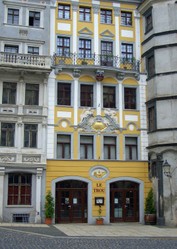


 The Alternative Picture Galleryon 04/20/2016
The Alternative Picture Galleryon 04/20/2016
 ROME - Where the Past Comes to Lifeon 03/26/2016
ROME - Where the Past Comes to Lifeon 03/26/2016
 Only in London - New Unique Guideon 01/25/2016
Only in London - New Unique Guideon 01/25/2016
 Manna, from Sicily, not from Heavenon 01/08/2016
Manna, from Sicily, not from Heavenon 01/08/2016

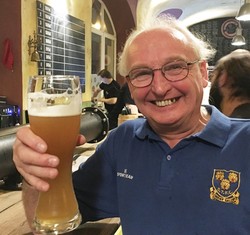
Comments